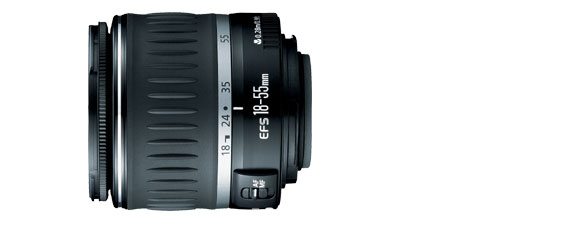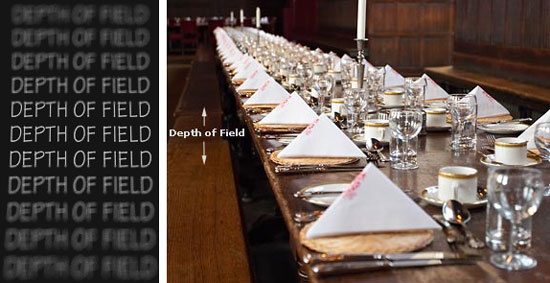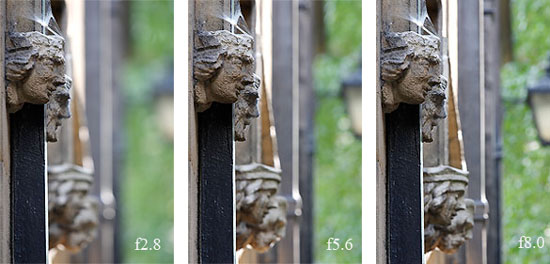Digital Photography from 20,000 Feet
by Wesley Fink on September 25, 2006 12:05 AM EST- Posted in
- Digital Camera
F Stop: The Speed of the Lens
Most buyers today are used to the idea of zoom lenses, and they aren't even aware of how many compromises the common "kit" zoom lens forces on them. The biggest compromise by far is lens speed. Film SLR cameras normally came with a normal lens that was rated at an f-stop of f1.7-1.8, where most zoom lenses are rated at speeds like f3.5-f5.6. What is F-Stop, anyway?
F-stop is the focal length divided by the diameter of the lens. For example, a 200mm f/4 lens will be 50mm wide. 200mm/50mm = f/4. That is why f-stop is typically written as F/4, meaning "focal-length over 4" or "focal-length divided by four".

The aperture scale is like the ISO film speed scale in reverse. Each full F-Stop is half the light of the earlier number, and the LOWER the number the more light the lens can pass. Lenses are marked with a range of f-stops. The maximum light-gathering ability of a lens is determined by the lowest number or f-stop, and the rest of the range is adjustments to reduce amount of light the lens will pass. Look at the f-stop scale:
1 - 1.4 - 2 - 2.8 - 4 - 5.6 - 8 - 11 - 16 - 22 - 32
The progression of f-stops are powers of the square root of 2. This means each number, as it increases in full f-stops, will pass half the light of the previous smaller number.

Let's return to yesterday's typical normal lens at f1.7 and today's standard zoom at f3.5-f5.6. F1.7 to 1.8 is a half f-stop, which is 1.5 times faster than f2.0, and f3.5 is a half f-stop between 2.8 and 4.0. So, under the best circumstances, the f1.7 lens is capable of passing FOUR times the light of the zoom lens. This is under the best circumstances, however, since the f5.6 is the other end of a variable aperture. At the f5.6 end, the f1.7 can pass TWELVE times the amount of light of the f1.7. So if we have a zoom lens that is rated 18-55mm f3.5-5.6, it is capable of passing ¼ the light of the f1.7 at the 18mm side, and 1/12 the amount of light of the f1.7 at the 55mm end of the zoom range. In between the amount varies smoothly from 1/4 to 1/12.
Buyers who wonder why they have trouble taking sharp indoor photos with a standard zoom now have their answer. You will have to crank up the ISO, turn on anti-shake if it's an option, or use a flash to supplement light if you plan to take the typical family indoor photos with a standard zoom lens. Or you could buy a normal lens while there are still some on the market and attach a lens that was designed to shoot images in available light.
Depth of Field
Fast lenses are great, in that they allow you to shoot in lower light than a slower lens. However, there is a price to pay for this low-light capability. All things being equal the faster the lens the shallower the depth of field. What do we mean by depth of field?

Depth of field is the amount of distance between the nearest and farthest objects that appear in acceptably sharp focus in a photograph. A "good" depth-of field is pretty subjective, since a shallow depth of field might be preferred in a portrait of your girlfriend, but a wide depth of field is preferred in landscape shots. A few factors affect depth of field; they are:
1) the diaphragm opening of the lens (the aperture or f-stop),
2) the focal length of the lens in use, and
3) image size (which has a direct relationship to distance from the subject).

The general rule of thumb is the bigger the lens opening (aperture) used (the smaller the f-stop) the more shallow the depth of field.
This means that critical focusing will be required with a large f-stop because when you use a large aperture - in particular when attempting to focus at a nearby subject - the zone of sharpness (DOF) can be very limiting. On the other hand, if extended depth of field is desired, you can just choose a smaller lens opening (larger f-stop like f/8, f/11, f/16, f/22) to extend the plane of sharpness, so everything will be in sharper focus.
Depth of field also increases with distance. This means the farther you place the camera from your subject, the greater the depth of field. Landscapes have great depth of field, while macro (close-up) photographs tend to have very little depth of field because the subject is so close to the lens.
Most buyers today are used to the idea of zoom lenses, and they aren't even aware of how many compromises the common "kit" zoom lens forces on them. The biggest compromise by far is lens speed. Film SLR cameras normally came with a normal lens that was rated at an f-stop of f1.7-1.8, where most zoom lenses are rated at speeds like f3.5-f5.6. What is F-Stop, anyway?
F-stop is the focal length divided by the diameter of the lens. For example, a 200mm f/4 lens will be 50mm wide. 200mm/50mm = f/4. That is why f-stop is typically written as F/4, meaning "focal-length over 4" or "focal-length divided by four".

The aperture scale is like the ISO film speed scale in reverse. Each full F-Stop is half the light of the earlier number, and the LOWER the number the more light the lens can pass. Lenses are marked with a range of f-stops. The maximum light-gathering ability of a lens is determined by the lowest number or f-stop, and the rest of the range is adjustments to reduce amount of light the lens will pass. Look at the f-stop scale:
1 - 1.4 - 2 - 2.8 - 4 - 5.6 - 8 - 11 - 16 - 22 - 32
The progression of f-stops are powers of the square root of 2. This means each number, as it increases in full f-stops, will pass half the light of the previous smaller number.

Let's return to yesterday's typical normal lens at f1.7 and today's standard zoom at f3.5-f5.6. F1.7 to 1.8 is a half f-stop, which is 1.5 times faster than f2.0, and f3.5 is a half f-stop between 2.8 and 4.0. So, under the best circumstances, the f1.7 lens is capable of passing FOUR times the light of the zoom lens. This is under the best circumstances, however, since the f5.6 is the other end of a variable aperture. At the f5.6 end, the f1.7 can pass TWELVE times the amount of light of the f1.7. So if we have a zoom lens that is rated 18-55mm f3.5-5.6, it is capable of passing ¼ the light of the f1.7 at the 18mm side, and 1/12 the amount of light of the f1.7 at the 55mm end of the zoom range. In between the amount varies smoothly from 1/4 to 1/12.
Buyers who wonder why they have trouble taking sharp indoor photos with a standard zoom now have their answer. You will have to crank up the ISO, turn on anti-shake if it's an option, or use a flash to supplement light if you plan to take the typical family indoor photos with a standard zoom lens. Or you could buy a normal lens while there are still some on the market and attach a lens that was designed to shoot images in available light.
Depth of Field
Fast lenses are great, in that they allow you to shoot in lower light than a slower lens. However, there is a price to pay for this low-light capability. All things being equal the faster the lens the shallower the depth of field. What do we mean by depth of field?

Depth of field is the amount of distance between the nearest and farthest objects that appear in acceptably sharp focus in a photograph. A "good" depth-of field is pretty subjective, since a shallow depth of field might be preferred in a portrait of your girlfriend, but a wide depth of field is preferred in landscape shots. A few factors affect depth of field; they are:
1) the diaphragm opening of the lens (the aperture or f-stop),
2) the focal length of the lens in use, and
3) image size (which has a direct relationship to distance from the subject).

The general rule of thumb is the bigger the lens opening (aperture) used (the smaller the f-stop) the more shallow the depth of field.
This means that critical focusing will be required with a large f-stop because when you use a large aperture - in particular when attempting to focus at a nearby subject - the zone of sharpness (DOF) can be very limiting. On the other hand, if extended depth of field is desired, you can just choose a smaller lens opening (larger f-stop like f/8, f/11, f/16, f/22) to extend the plane of sharpness, so everything will be in sharper focus.
Depth of field also increases with distance. This means the farther you place the camera from your subject, the greater the depth of field. Landscapes have great depth of field, while macro (close-up) photographs tend to have very little depth of field because the subject is so close to the lens.










81 Comments
View All Comments
silver - Monday, September 25, 2006 - link
I think this is one tidbit that you might write on when you're realy bored. My images are backed up using Verbatim UltraLife Gold DVD-R media. You also need to make sure that they stay cool and dry much as you do with film. They're not as sensitive to humidity but as certainly far more sensitive to heat.Googer - Monday, September 25, 2006 - link
Panasonic is makeing and selling cameras based on good old Leca Lens. If you have a leica lens from any point in the last 55+ years, it will be compatable with a Panasonic/Leica Camera.
Wesley Fink - Monday, September 25, 2006 - link
The Pansonic Lumix DMC-L1 digital SLR uses a Leica lens built with a four thirds mount. This is the new digital only mount pioneered by Olympus. The LMC-L1 is mentioned in the guide.silver - Monday, September 25, 2006 - link
One of my friends has one of these and the images are simply incredible. He states that the Opticla Image Stabilization is simply the best he could find.wilburpan - Monday, September 25, 2006 - link
As someone used to shooting with film cameras, I can say that I still notice some shutter lag when using digital SLRs, even with current models. To write this off as "Virtually none of the lags of early digital cameras remain" is to ignore a real factor when it comes to the use of any camera.To put this another way, if a digital camera website stated that the choice of CPUs was unimportant in buying a computer because all modern day CPUs were fast and powerful enough, the readers of this site probably would bust a gut.
There are also speed issues involved with other uses of a digital camera that need to be addressed. The Nikon D80 takes about 1.4 seconds to store and then display an image after the shutter has been pressed. The speed of this process varies widely from camera to camera. Similar variances in speed and performance come into play when performing tasks such as playback of pictures taken, the time that it takes to process bursts of photos when shooting in continuous mode, etc.
silver - Wednesday, September 27, 2006 - link
Regarding shutter lag, digital cameras will always be slower than film. There's no way around that. My FM2n's have near instantaneous shutter release and are quite the opposite of my admittedly dated Fuji S602. What manufacturers need to do is to have separate power sources (batteries) for lens focusing and camera functions other than CCD/CMOS/memory charging. Obviously this would complicate the camera so they probably aren't considering this option.Wesley Fink - Monday, September 25, 2006 - link
This is where we start to get into questions about what test is real. The file flush time on a Nikon D80 is 2.0 seconds for a fine jpeg and a little less than 3s for a RAW+jpeg. However, you never encounter this becuase of the memory buffering built into the Nikon D80 and every other digital SLR camera. The D80 can do 3 fps for a little over 30 seconds shooting raw+jpeg, and with fine jpeg it can shoot 3fpm until you run out of flash card room or battery.I consider the D80 time of 160ms viewfinder blackout (0.16s), and a less than 0.1s from off to shot negligible for almost any users. Even the Sony, which has a 1 second start-up, is using almost all that time to clean the sensor before shooting, while shot-to-shot is very competitive with the best SLRs around. Some users might be happier if you could turn off the cleaning on start. While this may be very important for some users, it is doubtful that the small differences in recent digital SLR cameras will really be noticable or matter to most users.
dpreview is an excellent and respected digital review site, and I have sent many readers there with their questions. They often come back with more questions than answers, which usually means they found the technical level too far above their skills and needs. We can't be all things in Digital Camera reviews so we will likely err toward the more basic side.
We'll consider your suggestion about start-up times, but I'm not convinced yet.
yacoub - Monday, September 25, 2006 - link
I appreciate your article but I don't know: I think that folks into digital photography, no matter what other hobbies they have, including computer hardware or gaming, are knowledgable enough (or are competent enough to gain the knowledge needed) to make good use of a site like DPReview, which offers about all the info most need to make an intelligent purchase of a digital camera. Plus that being their primary focus (and has been for years), they automatically get much more credibility than a computer hardware site can hope to achieve by writing content basically saying "look we can do this too!" and writing what most good highschool photography classes are teaching today anyway.I guess my question is, why not stay focused on computer component hardware? All branching out does is reduce the chance of the main hardware getting the attention it needs. There are umpteen motherboard, videocard, and RAM reviews and guides yet to be completed or even begun, yet you're going off into digital photography land? That's kind of disappointing. For that hobby there are already many strong resources for folks who are into that, and many more for folks who want a simple pocket-sized point-n-shoot (which is the majority of folks). Why not focus on being the strong resource in computer hardware that folks in this hobby need?
fanbanlo - Monday, September 25, 2006 - link
Maybe AnandTech can explain to use what are the new technology built into the sensor rather than meaningless marketing terms givin to them.Different algorithm used? what's their computational power?
Why shoot RAW? RAW-enabled software review!?
Thx
Heidfirst - Monday, September 25, 2006 - link
For the lower end DSLRs (D50,350D,K100D etc.) I think that you should also review the standard kit lens as the majority of buyers will probably be buying it with the body as a package.By the time that you start hitting EOS30D type level imo most people will probably have lenses already or be buying a better lens than the entry level kit lens. Also if they are paying that for a body they quite probably are reasonably knowledgeable photo enthusiasts & maybe Anandtech isn't going to be the first place that they look for reviews so sticking to the lower end at least initially sounds reasonable to me.
The idea of a standard test scene is interesting but it would have to be reproducible which means in the studio & that means that it's less representative of the conditions in which most people will use them (I imagine that the % of even current DSLR users who shoot in the studio is in single figures & probably low single figures at that).